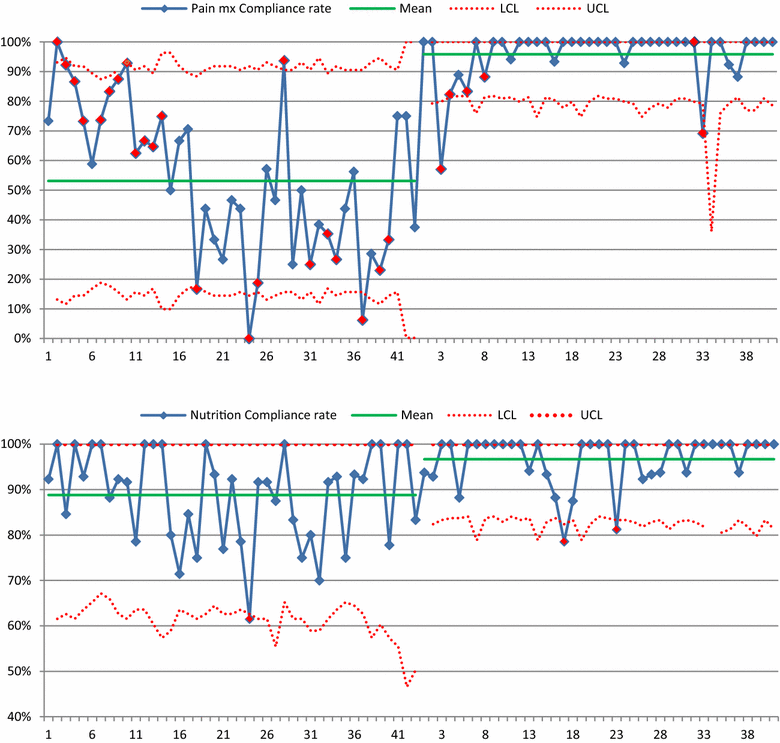Testing the implementation of an electronic process-of-care checklist for use during morning medical rounds in a tertiary intensive care unit: a prospective before-after study
- PMID: 26239145
- PMCID: PMC4523566
- DOI: 10.1186/s13613-015-0060-1
Testing the implementation of an electronic process-of-care checklist for use during morning medical rounds in a tertiary intensive care unit: a prospective before-after study
Abstract
Background: To improve the delivery of important care processes in the ICU, morning ward round checklists have been implemented in a number of intensive care units (ICUs) internationally. Good quality evidence supporting their use as clinical support tools is lacking. With increased use of technology in clinical settings, integration of such tools into current work practices can be a challenge and requires evaluation. Having completed preliminary work revealing variations in practice and evidence supporting the construct validity of a process-of-care checklist, the need to develop, test and further validate an e(lectronic)-checklist in an ICU was identified.
Methods: A prospective, before-after study was conducted in a 19-bed general ICU within a tertiary hospital. Data collection occurred during baseline and intervention periods for 6 weeks each, with education and training conducted over a 4-week period prior to intervention. The e-checklist was used at baseline by ICU research nurses conducting post-ward round audits. During intervention, senior medical staff completed the e-checklist after patient assessments during the morning ward rounds, and research staff conducted post-ward round audits for validity testing (via concordance measurement). To examine changes in compliance over time, checklist-level data were analysed using generalised estimating equations that factored in confounding variables, and statistical process control charts were used to evaluate unit-level data. Established measures of concordance were used to evaluate e-checklist validity.
Results: Compliance with each care component improved significantly over time; the largest improvement was for pain management (42% increase; adjusted odds ratio = 23, p < 0.001), followed by glucose management (22% increase, p < 0.001) and head-of-bed elevation (19% increase, p < 0.001), both with odds ratios greater than 10. Most detected omissions were corrected by the following day. Control charts illustrated reduced variability in care compliance over time. There was good concordance between physician and auditor e-checklist responses; seven out of nine cares had kappa values above 0.8.
Conclusion: Improvements in the delivery of essential daily care processes were evidenced after the introduction of an e-checklist to the morning ward rounds in an ICU. High levels of agreement between physician and independent audit responses lend support to the validity of the e-checklist.
Figures

Similar articles
-
Optimizing ward rounds: systematic review and meta-analysis of interventions to enhance patient safety.Br J Surg. 2025 Mar 28;112(4):znaf041. doi: 10.1093/bjs/znaf041. Br J Surg. 2025. PMID: 40202092 Free PMC article.
-
Intelligent checklists improve checklist compliance in the intensive care unit: a prospective before-and-after mixed-method study.Br J Anaesth. 2021 Feb;126(2):404-414. doi: 10.1016/j.bja.2020.09.044. Epub 2020 Nov 17. Br J Anaesth. 2021. PMID: 33213832
-
Developing content for a process-of-care checklist for use in intensive care units: a dual-method approach to establishing construct validity.BMC Health Serv Res. 2013 Oct 3;13:380. doi: 10.1186/1472-6963-13-380. BMC Health Serv Res. 2013. PMID: 24088360 Free PMC article.
-
Intensive care unit rounding checklist implementation. Effect of accountability measures on physician compliance.Ann Am Thorac Soc. 2015 Apr;12(4):533-8. doi: 10.1513/AnnalsATS.201410-494OC. Ann Am Thorac Soc. 2015. PMID: 25642750
-
A Pediatric Intensive Care Checklist for Interprofessional Rounds: The R-PICniC Study.Am J Crit Care. 2022 Sep 1;31(5):383-389. doi: 10.4037/ajcc2022533. Am J Crit Care. 2022. PMID: 36045045 Review.
Cited by
-
Systematic Evaluation of the Effect of Bedside Ward Round Checklist on Clinical Outcomes of Critical Patients.J Healthc Eng. 2021 Dec 15;2021:8105516. doi: 10.1155/2021/8105516. eCollection 2021. J Healthc Eng. 2021. PMID: 34956577 Free PMC article.
-
Optimizing ward rounds: systematic review and meta-analysis of interventions to enhance patient safety.Br J Surg. 2025 Mar 28;112(4):znaf041. doi: 10.1093/bjs/znaf041. Br J Surg. 2025. PMID: 40202092 Free PMC article.
-
Impact of Rounding Checklists on the Outcomes of Patients Admitted to ICUs: A Systematic Review and Meta-Analysis.Crit Care Explor. 2024 Aug 20;6(8):e1140. doi: 10.1097/CCE.0000000000001140. eCollection 2024 Aug 1. Crit Care Explor. 2024. PMID: 39162653 Free PMC article.
-
Effect of a quality improvement program on compliance to the sepsis bundle in non-ICU patients: a multicenter prospective before and after cohort study.Front Med (Lausanne). 2023 Nov 13;10:1215341. doi: 10.3389/fmed.2023.1215341. eCollection 2023. Front Med (Lausanne). 2023. PMID: 38020128 Free PMC article.
-
Bedside or not bedside: Evaluation of patient satisfaction in intensive medical rehabilitation wards.PLoS One. 2017 Feb 7;12(2):e0170474. doi: 10.1371/journal.pone.0170474. eCollection 2017. PLoS One. 2017. PMID: 28170431 Free PMC article.
References
-
- Hewson-Conroy KM, Burrell AR, Elliott D, Webb SAR, Seppelt IM, Taylor C, et al. Compliance with processes of care in intensive care units in Australia and New Zealand- A point prevalence study. Anaesth Intens Care. 2011;39:926–935. - PubMed
LinkOut - more resources
Full Text Sources
Other Literature Sources

